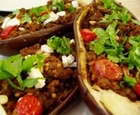|
Turkish Side Stuffed Eggplant Serve this elegant dish hot or cold. Or turn it into a main course by adding cubed or ground lamb to the filling.
Eggplant: preheat oven to 400. Bake eggplants on the rack for 15-20 minutes, turning frequently, till soft to touch. Be careful not to prick the skins. Remove from oven and reduce temperature to 350. When cool enough to handle, halve eggplants lengthwise and scoop out flesh, leaving a 1/2"-thick shell. Try not to pierce the shells. Set aside. Chop or cut eggplant meat into 1/2" cubes and set aside. Filling: saute onions in 2 T of the oil till translucent. Add garlic and stir 2 more minutes. Add tomatoes and salt and cook, covered, 5 minutes. Add bay leaf, cinnamon, sugar, parsley, and about 4 C of the eggplant flesh. Cook 10 minutes over medium heat, uncovered. Remove bay leaf and stir in almonds. Assembly: arrange 4 eggplant shells in a greased pan, large enough to hold them without crowding. Divide the filling equally among 4 shells. Sprinkle with remaining 4 T oil (1 T oil per eggplant) and bake 20 minutes. Sprinkle with parsley and serve hot. * * You can also serve this dish cold: Make a vinaigrette by combining 2 T lemon juice, 1/4 tsp. salt, and 1/8 tsp. sugar with the 4 T of oil (the oil you would have used right before baking). Shake to blend. After cooking the eggplant mixture for 10 minutes on the stove top (as in the recipe), toss the mixture with vinaigrette. Do not stuff the shells. Instead, refrigerate 2-3 hours, along with the shells. When filling is chilled, toss again to blend, and stuff eggplants. Sprinkle with chopped parsley, and serve cold. |
Tips & Glossary You may not have all the ingredients used in Turkish cooking on your spice shelf, but you'll find them at Middle-East food stores. To avoid frustration, make a list of items you need before trying out the recipes. Cumin: an aromatic, kin to parsley and carrots; an important ingredient in chili powder. Used especially in Indian curries, as well as in Mid-Eastern, Mexican, and Asian dishes. It has an earthy, peppery flavor. Filo: aka phyllo, paper-thin sheets of raw, unleavened flour dough. Buy frozen in any grocery store and follow directions on package for thawing. When working with one sheet, keep others covered with a damp towel to prevent drying out. Peeled Tomatoes: choose 1 of 2 methods: 1) hold tomatoes one-at-a-time over gas flame till skin bubbles and becomes charred; 2) drop all tomatoes into pot of boiling water for 45 seconds. After either method, run tomatoes under running water; skins will slip off easily. Roasted peppers: buy them prepared. Or make your own: place peppers under a broiler, or hold over a gas flame, till skin chars and blisters. Place them in a closed paper bag for 15-20 minutes (to steam them). When cool enough to handle, the skins slip off under running water. Rosewater: distilled from rose petals and used to flavor Mid-Eastern and Asian cooking. You can make your own—but why? Purchase it at Mid-East or Asian or food stores. Saffron: the most expensive spice in the world, from the crocus plant, and cultivated in Iran and Spain. Along with its unusual taste, it adds a deep rich yellow color to food. Use a strand or two at a time and soak in warm water before using. Skewers: use metal or wooden skewers for kabobs. If wooden, be sure to soak them for 30 minutes before using to prevent them from catching on fire.
|
Site by BOOM
![]()
LitLovers © 2024

